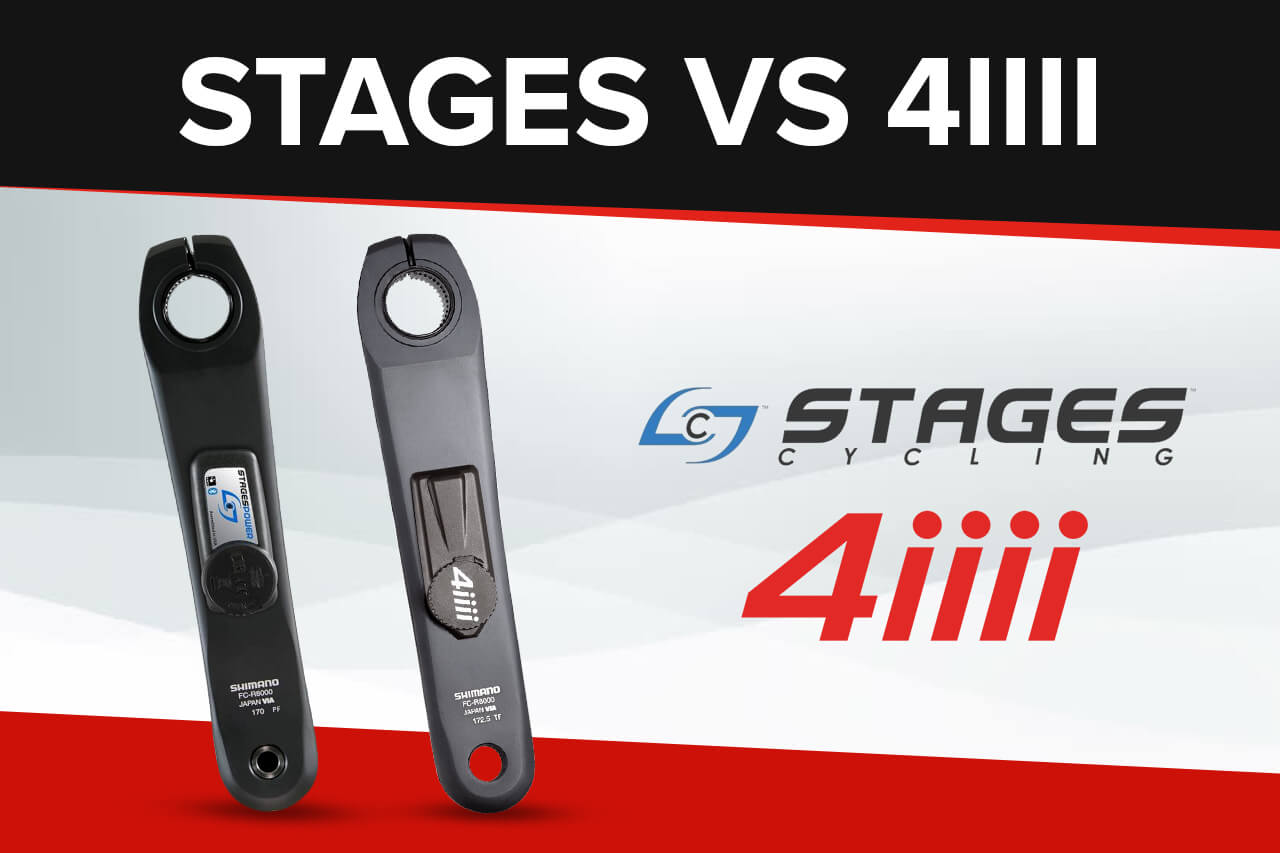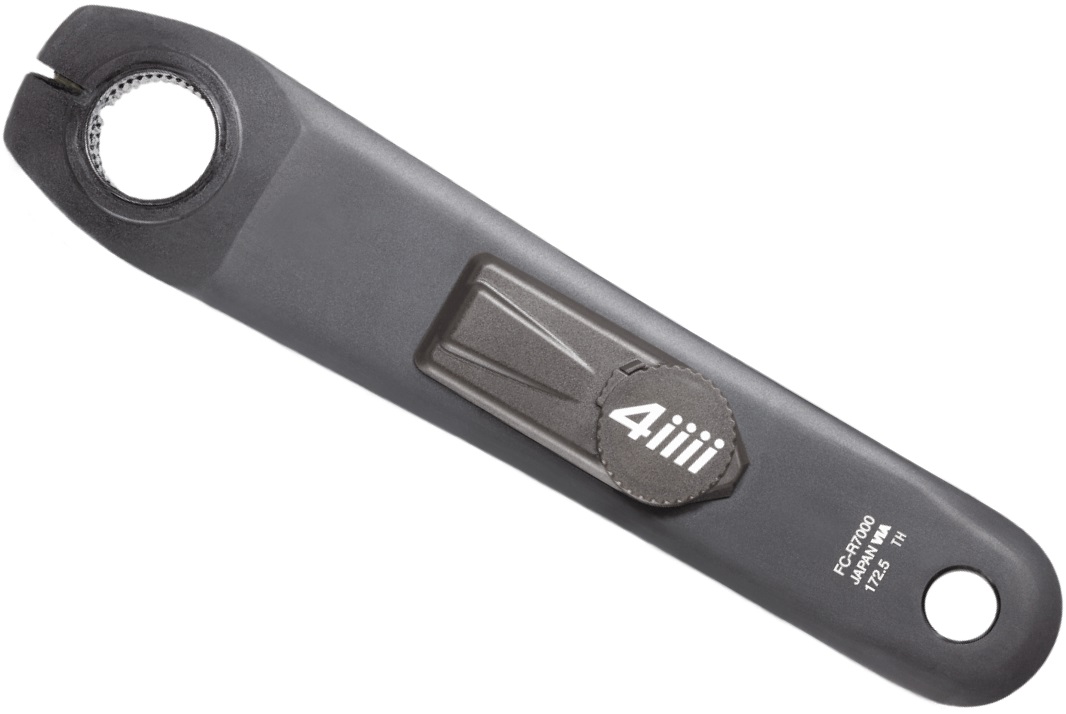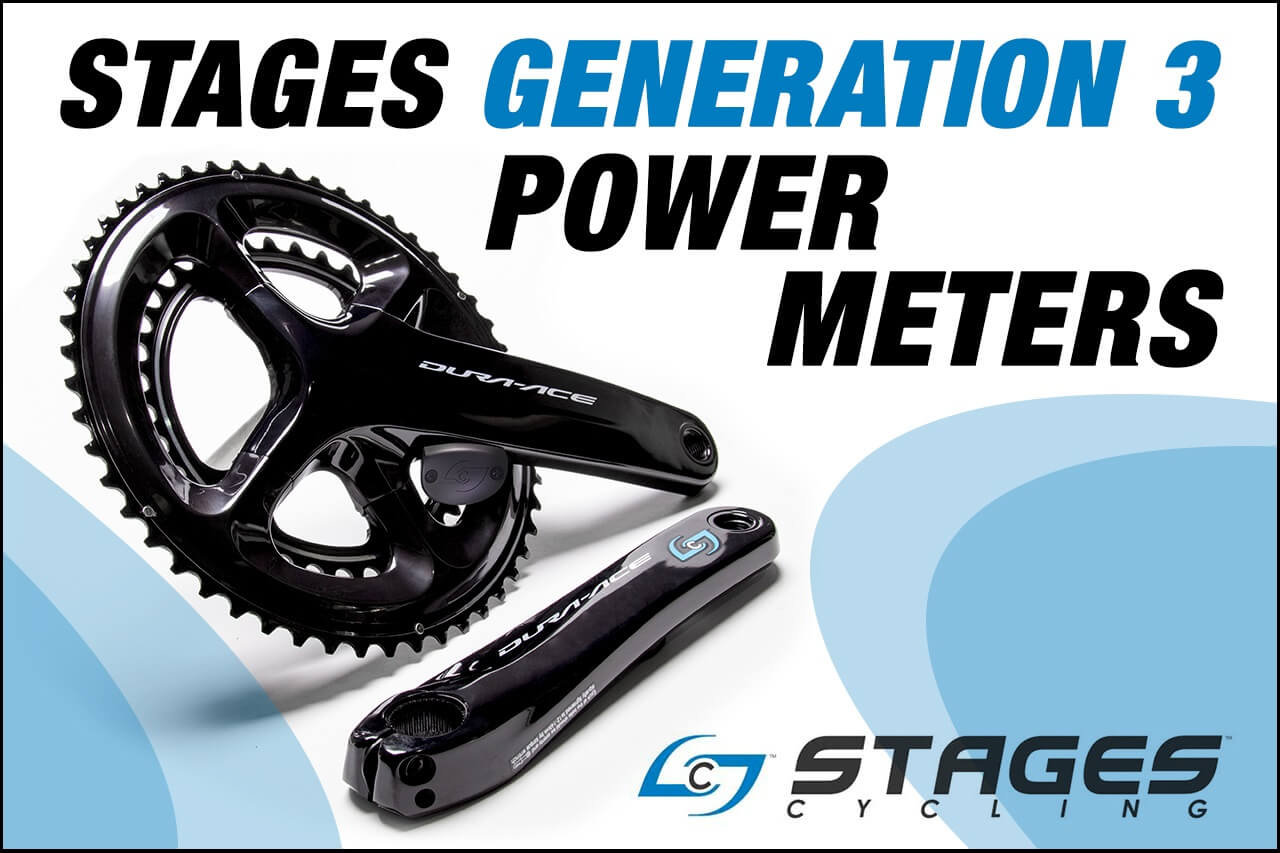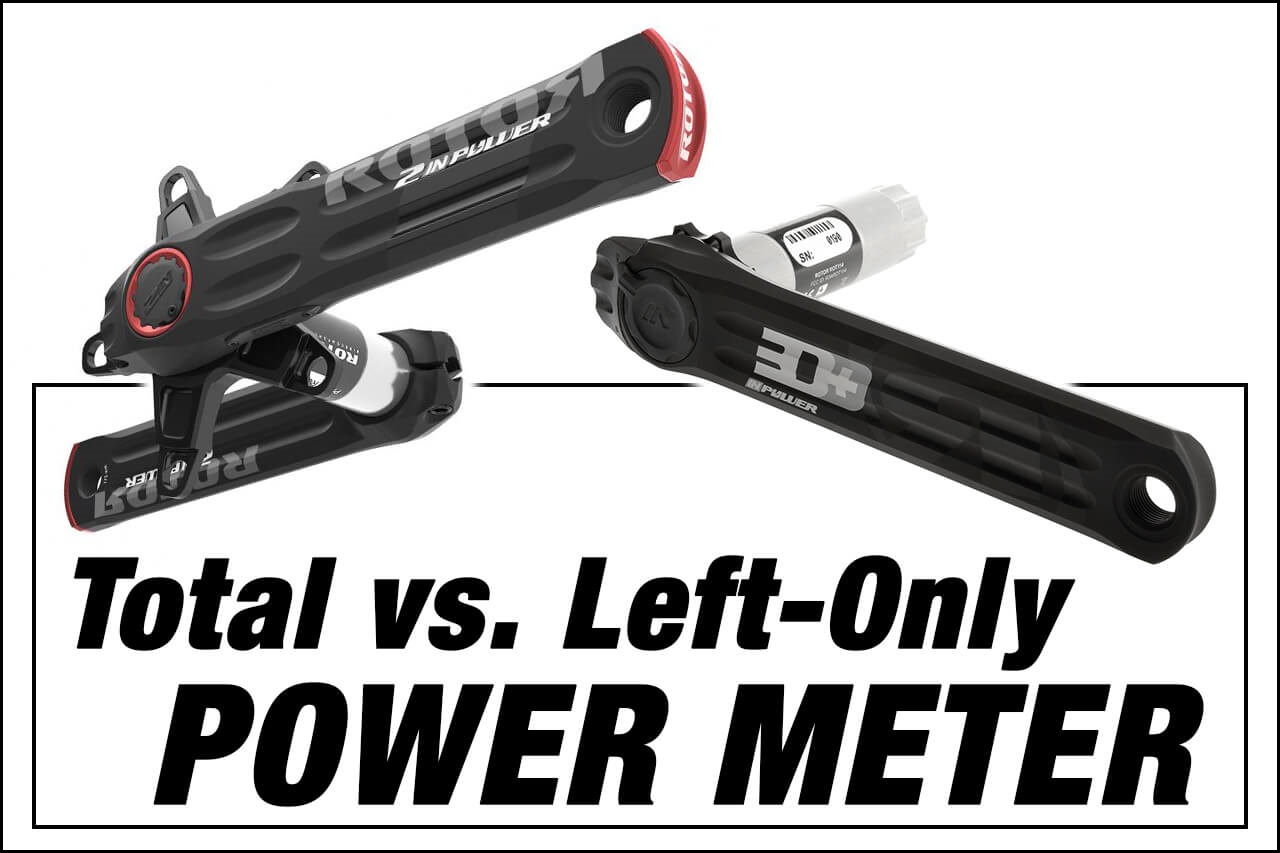Stages Cycling shook up the power meter market back in 2012 with the introduction of their left-side crank arm power meter. Unlike previous power meters at the time (cranks or hubs), the Stages was a left-side crank arm measuring left leg power. This meant you simply swapped out your current crank arm for a new, power equipped one. Easy stuff! It was also the first power meter to use both ANT+ and Bluetooth SMART wireless protocols. While Stages was first to the party with this type of power meter, 4iiii Innovations quickly followed suit, producing its own version of a left-side crank arm power meter. While the power meters produced by these companies share many similarities…they are not without their differences. So, we thought it would be helpful if we conducted a Stages vs 4iiii crank arm power meter comparison – and put these two power meters head-to-head!

Why Crank Arm Power Meters Are Popular
Left-side crank arm power meters are one of the most popular power meters you can buy. Here’s why:
- Affordable – Since you are just buying the left-side crank arm (instead of an entire crankset, new set of pedals, etc.), they are one of the more affordable power meters you can buy. In fact, 4iiii has models starting at $285 and Stages has models at $325. This makes them the most affordable direct force power meters available.
- Easy to install – This design allows for easy installation and swapping of the power meter between bikes. The power meter can be installed or moved between bikes in about 5-10 minutes.
- Lightweight – They are extremely lightweight. These power meters only add about 10-20 grams (based on the model) to your bike.
The Trade Off…
Ok, so what’s the catch? The drawback to a left-side crank arm power meter is…well…just that. It’s left-side only. It takes your left leg power and doubles it to approximate your total power. This is how all left-side power meters work. To be true, this type of power measurement is fine for most folks. However, if you are looking for the most accurate option available, you might be better off with a power meter that measures both legs (Stages and 4iiii actually make some of these too!).
So if you’re okay with a left-only power meter and like things like affordability, ease of installation and lightweight – and of course have a compatible crankset, than a Stages or 4iiii might be right for you. Below, we briefly summarize these two power meters and put them head-to-head across several key considerations you’ll likely want to consider.
About Stages Cycling and 4iiii Innovations
Stages Cycling

Stages Shimano Ultegra R8100 Power Meter
Stages Cycling got their start in the indoor fitness market, manufacturing power-equipped indoor cycling bikes. Starting in 2010, they began work on an outdoor version of their power meter and by 2012, they were producing what is now referred to as the Stages Cycling power meter.
The Stages power meter was the first power meter to use both ANT+ and Bluetooth SMART protocols, as well as Active Temperature Compensation, which works to keep the power meter accurate regardless of temperature changes during your ride.
The company currently offers their Stages generation 3 power meters which feature a stronger transmitter, among other refinements, over the previous version. Stages offers a range of models for road, MTB, gravel and track. Compatible cranksets include Shimano, Campagnolo, FSA, Cannondale, SRAM, Easton, Specialized and Race Face. They also make carbon arms for select cranksets. Prices range from $335 to $925 (for left-side crank arms).
4iiii Innovations

4iiii PRECISION 3+ Shimano R7000 Power Meter
4iiii Innovations is based in Alberta Canada and develops a range of sports performance technologies. The company entered the power meter market in late-2014, unveiling the PRECISION, the world’s lightest power meter.
Like the Stages, the 4iiii power meter is a left-side crank arm power meter that takes your left leg power and doubles it to approximate total power. 4iiii units feature ANT+ and Bluetooth SMART, are accurate to +/- 1.0% and run off of a CR2032 battery.
4iiii’s newest model, the PRECISION 3+, uses an ultra-slim battery compartment for improved frame clearance and features an industry-leading 800 hours of battery life.
However, unlike the Stages, 4iiii ride ready power meters are only compatible with Shimano road, MTB and gravel cranksets. Prices range from $335 to $500 (for left-side crank arms).
Head-to-Head Stages vs 4iiii Comparison
Installation
Tie
Both the Stages and 4iiii left-side crank arms install the same way. You simply remove your current, left-side crank arm and replace it with your new, power-equipped version. Installation typically takes about 5-10 minutes for most models. Some models, such as the Stages Carbon power meters, require you to change out your spindle as well, and this adds an extra step to the process. But it is still a relatively basic process. It can be performed at home in your garage as long you have access to some Allen keys and a torque wrench. Note that for most Shimano models, you will also need a Shimano Crank Arm Cap Tool.
Weight
Tie
In general, crank arm-based power meters are one of the lightest power meters you can buy. This is because the added weight of the sensor that is bonded to the inside of the crank arm weighs practically nothing. For example, 4iiii sensors add a mere 9 grams to your crank while Stages sensors add about 20 grams. Since the difference here is only about 10 grams, we’re calling this a tie.
Battery Type
Tie
Both the Stages and 4iiii crank arm power meters run off of 2032 coin cell batteries. This is a very common battery amongst power meter manufacturers. It’s relatively small, affordable, easy to source and provides good run time.
Battery Life
4iiii gets the win here. Their new PRECISION 3+ features a whopping 800 hours of battery life. This is pretty amazing considering the power meter runs off of a single CR2032 battery. This compares to 200 hours for the Stages. Note that 200 hours for the Stages isn’t at all bad, but you get 4x this with the 4iiii. We also note that because CR2032 batteries are cheap easily changed, we don’t consider this a huge deciding factor…but more battery life is always good thing.
Ability to Easily Change Batteries
Tie
Battery changes on these crank arms couldn’t be easier and it’s done the same way for both. You pop open a small black battery door on the sensor, remove the old battery and insert the new one. No special tools required. It’s a one-minute job.
Quick tip – you will find a small O-ring on located around the battery compartment. It serves to keep moisture out. So when changing batteries, make sure the O-ring is in place and is in good condition. In the event you lose or damage the battery door, no worries. We sell Stages replacement battery doors and 4iiii replacement battery doors.
Communication Protocol
Tie
All of these crank arm-based power meters transmit power and cadence data via both the ANT+ and Bluetooth SMART wireless protocols. This makes the power meters compatible with your favorite head unit, smart phone or tablet.
Some people have complained about dropouts with the Stages power meters when using ANT+. It’s true the Stages Generation 2 power meters suffered from this in some specific situations. However, this is no longer a concern. The Stages Generation 3 power meter features radio antennas that are 6x more powerful than the previous version. We’re yet to hear of a signal issue of signal loss with the Stages Generation 3 Stages units.
Accuracy
Tie
We are going to call this one a tie as well. 4iiii claims an accuracy of +/- 1.0% and Stages +/- 1.5%. However, the 0.5% difference we are talking about here is minimal. In addition, it’s really hard to validate this differential. Third party tests have shown these power meters to track other, popular power meter models closely. Is it possible that the 4iiii is slightly more accurate…perhaps, but in the grand scheme of things, we don’t think this should be a deciding factor.
Active Temperature Compensation
Tie
As the temperature changes during your ride, the material that houses the tiny strain gauges within the power meter can expand and contract. As this material shifts, it can ever-so-slightly bend or torque the strain gauges. This can negatively impact the accuracy of the power meter. Enter active temperature compensation. This technology allows the power meter to adjust for changes in temperature during your ride, which helps keep the power meter accurate in all weather conditions. Both the Stages and 4iiii power meters features this technology – so all good here. Another tie.
Cadence Detection
Tie
Both crank arm power meters measure cadence, so this is a tie. In addition, they both do so using an accelerometer, which is an electronic device that is housed inside the power meter that measures the acceleration of the crank arm.
Calibration
Tie
Both power meters require the user to perform a calibration (technically called a zero-offset) procedure before every ride. The process of zero-offsetting can be done via the power meter’s app or your head unit. It takes all of 15 seconds and ensures accurate power for your ride.
Warranty
The 4iiii comes with a 3-year warranty, so it gets the win here. This compares to 1 year for Stages.
Frame Compatibility
Crank-arm based power meters like the ones on this page, attach a sensor to the inside of the left crank arm. On some bikes, there is not enough room between the left crank arm and the chainstay for the sensor to clear the frame. The 4iiii PRECISION 2 and Stages sensors are approximately 7.5 mm thick. This means you need close to 10 mm of space between your left crank arm and frame for the power meter to fit – 7.5 mm for the sensor and 2-2.5 mm of extra room as the crank arm will flex a bit as you ride.
However, the 4iiii PRECISION 3+ uses a new, slim sensor that is only about 5 mm thick. This means, you only need close to 7 mm of total clearance with the PRECISION 3+ (vs. 10 mm for the Stages). This renders most incompatibility issues a thing of the past.
Crankset Compatibility
Stages Cycling takes a big win here and this is one of the biggest differences between these brands. The company makes crank arms that are compatible with Shimano, Campagnolo, FSA, Cannondale, SRAM, Race Face, Easton and Specialized cranksets. They offer carbon arms as well as versions for road, MTB and track. 4iiii on the other hand, only offers road and MTB crank arms for Shimano.
Oval Chainrings
Tie
While both the Stages and 4iiii power meters can be used with oval chainrings, the oval rings will influence or skew the accuracy of the power meters. We note this is pretty normal as many power meters are impacted by the use of oval chainrings. Specifically, 4iiii states the while the error resulting by oval chainrings will depend on the ovality of the ring, you can expect a 1-4% over-estimation of power. Likewise, Stages estimates it can be as much as 4-5% higher.
Again, we want to emphasize that mechanically, it’s perfectly ok to use these power meters with oval rings. However, you simply need to make note that the use of an oval ring with your 4iiii or Stages power meter will likely result in a slight overestimation of power.
Smart Phone App Functionality
Tie
Both of these power meters feature Bluetooth SMART compatibility and also have dedicated cycling apps. The apps are free and are available for both iOS and Android. While there are definitely some differences in the apps – the 4iiii app is the only one that lets you record ride data – there are also similarities. For example, they both allow you to update firmware and conduct your pre-ride zero-offset. We’re calling this a tie as the there’s too much subjectivity to determine a clear winner.
Cost
Ok, so we saved the big one for last. We’re going to focus on Shimano versions here because it’s the one model sold by both companies. As you can see in the table below, across most models, 4iiii PRECISION power meters are the lower cost option. On average, PRECISION 2 models are about 15% cheaper than Stages models while 4iiii’s newest PRECISION 3+ models are about 5% less than Stages. Eventually, we expect 4iiii to discontinue the PRECISION 2, and at that point, the cost comparison will be closer.
This table also highlights some differences regarding availability of certain models. When it comes to road, you can see that Stages offers right only crank arms, whereas 4iiii does not. However, 4iiii offers a R7000 Dual-sided crankset (a great value for a dual-sided road power meter), but Stages doesn’t.
In regards to GRX gravel power meters, 4iiii makes left-, right- and dual-side units, whereas Stages offers only left-side crank arms.
Lastly, on the MTB side of things, Stages again offers right only crank arms, whereas 4iiii doesn’t.
| 4iiii PRECISION 2 | 4iiii PRECISION 3+ | Stages Cycling Gen. 3 | |
| Road - Left Side | |||
| 105 R7000 | NA | $334.99 | $334.99 |
| Ultegra R8000 | $299.99 | $389.99 | $389.99 |
| Ultegra R8100 | NA | $444.99 | $449.99 |
| DURA-ACE 9200 | NA | $514.99 | $514.99 |
| Road - Right Side | |||
| Ultegra R8000 | NA | NA | $494.99 |
| Ultegra R8100 | NA | NA | $514.99 |
| DURA-ACE 9200 | NA | NA | $764.99 |
| Road - Dual Sided | |||
| 105 R7000 | $619.99 | NA | NA |
| Ultegra R8000 | $749.99 | NA | $814.99 |
| Ultegra R8100 | $849.99 | NA | $864.99 |
| DURA-ACE 9100 | $949.99 | NA | NA |
| DURA-ACE 9200 | $1049.99 | NA | $1,224.99 |
| CX/Gravel - Left Side | |||
| GRX RX810 | $299.99 | $389.99 | $389.99 |
| CX/Gravel - Right Side | |||
| GRX RX810 | $467.99 | NA | NA |
| CX/Gravel - Dual Sided | |||
| GRX RX810 | $772.99 | NA | NA |
| MTB - Left Side | |||
| XT M8100 | $299.99 | $384.99 | $389.99 |
| XTR M9000 | $349.99 | NA | NA |
| XTR M9100 | $399.99 | $514.99 | $589.99 |
| MTB - Right Side | |||
| XT M8100 | NA | NA | $494.99 |
| XTR M9100 | NA | NA | $749.99 |
| MTB - Dual Side | |||
| XT M8100 | NA | NA | $814.99 |
| XTR M9100/9120 | $971.99 | NA | $1,299.99 |
Stages vs 4iiii Summary
As you can see, and as we mentioned at the outset, these power meters share many similarities. They are indeed very similar products. But there are some differences as well. Most notably:
- Crankset compatibility – Stages is compatible across a wider range of cranksets
- Warranty – 4iiii has a longer, 3-year warranty
- Battery life – 4iiii PRECISION 3+ models feature an industry leading 800 hours of battery life
- Frame compatibility – 4iiii PRECISION 3+ models use a slimmer sensor that fits more bikes
- Price – 4iiii PRECISION 2 power meters are priced 15% lower, on average
We’ve personally owned and trained on both of these power meters and they’ve been great. It really comes down to what’s important to you – and quite frankly, what equipment you’re currently running. If you have a Shimano crankset and want to save some money, the 4iiii PRECISION 2 is probably a great choice. Or, if you know that frame clearance is tight on your bike, the 4iiii PRECISION 3+ will give you a great chance of compatibility. You’ll also benefit from the longer battery life and 3-year warranty.
However, if you have a non-Shimano crankset, Stages offers a much wider selection of compatible power meters. Their units sell very well and we get a lot of great customer feedback on them. We are pretty confident that regardless of your choice, you’ll enjoy it and will be a stronger cyclist for training with power!

 Stages Shimano Ultegra R8100 Dual-Sided Power Meter
Stages Shimano Ultegra R8100 Dual-Sided Power Meter  4iiii PRECISION 3+ Shimano R7000 Power Meter
4iiii PRECISION 3+ Shimano R7000 Power Meter  Stages Shimano XT M8100/8120 Power Meter
Stages Shimano XT M8100/8120 Power Meter 


4iii is compatible with more than shimano
Hi, I have a brand new Ultegra left hand crank off a 2022 trek emonda (175mm length). Thgis was taken off when I bought the bike as I put a 4iii power meter on. The bike has since been run over (with me on it) so the crank wont be needed. Is this any use for conversion to a new power meter by your company (given I will need to ship it from Australia)?
Cheers
Ben
Hi Ben. We’re sorry to hear about your accident and hope you are recovering well! At the moment we don’t have any sort of trade in program, but will reach out if this changes. Thanks!
In the case of Stages’ Shimano power meters, I’ve read that they aren’t as accurate as power meters from those who manufacture the entire crankset rather than simply attaching a power pod to a stock crank arm. This came up recently when Shimano announced that they will be coming out with Dura-Ace and Ultegra power meter cranksets that will be a big improvement over their prior cranksets, which were infamous for their inaccuracy. Apparently the Shimano engineers claimed that they couldn’t nail down the accuracy of their prior cranksets because they were manufactured by simply retrofitting the strain gauges on a standard alloy crank and those cranks wouldn’t deflect in a way that could provide consistent power readings. The new Shimano power meter cranksets will apparently be built from the ground up with crank arms with strain gauges integrated into the manufacturing materials to provide accurate power readings. Does this sound plausible and have you seen any issues with power meters that attach their power pods to stock cranks (specifically Stages Shimano power meters)?
Thanks for the great content on this site. A.
Hi A. Thanks for the comment! I read your question loud and clear. However, it’s a tough one to answer. Indeed the manufacturers that integrate their sensors into the spiders, for example, claim superior accuracy. However, 4iiii and Stages do extensive testing and also cite high levels of accuracy with their units. At the end of the day, I think it’s about finding a power meter that is compatible with the components on your bike, is in your price range, and puts a big smile on your face when you ride – whether that’s a crank-arm based power meter or something else!
You got mixed up with whether Pioneer or Stages has active temp comp. between the summary and the main text.
Hi Jake. Thank you. Fixed!
Hi, I have a Campy 12 spd Super record crank that i will like to install with either Stages or 4iiii left sided. Is any of the above PM compatible? I am staying in Singapore.
Regards
Hi Robert. Yes, we sell the Stages Campy Super Record 12-Speed crank arm. 4iiii doesn’t currently offer a version for Campy.